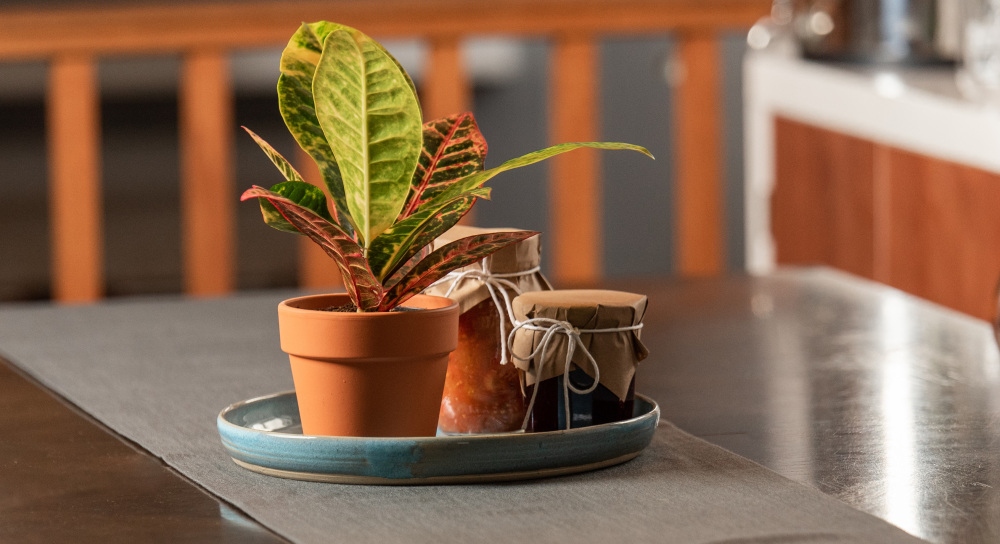
Known for their striking colorful leaves, crotons can instantly transform your home into a tropical paradise. However, their unique plant care requirements can be a bit challenging for beginners. In this blog, we will explore the essential aspects of caring for your Croton plant, from lighting to watering, to soil and fertilizer, We cover all the bases to ensure you keep your Croton thriving for many months to come.
Croton (Codiaeum variegatum) is a tropical plant native to Southeast Asia and the Pacific Islands. Its distinct feature lies in its diverse range of foliage colors, including shades of green, yellow, orange, red, and even purple. Croton plants can grow up to 3 to 6 feet in height and people can keep them both indoors and outdoors, depending on the climate, with the right care provided.
Croton plants thrive in bright, indirect light. Place them near a window with filtered sunlight. Avoid exposing them to direct sunlight, as this can scorch their leaves. However, if your Croton's leaves start losing their vibrant colors, it could be a sign that the light is too low. Adjust the location of your plants accordingly.
Maintaining the right temperature and humidity levels is crucial for croton plants. They prefer temperatures between 60°F to 80°F (15°C to 27°C). Avoid placing them in drafty areas or near heaters or air conditioners. Additionally, crotons thrive in high-humidity environments. If your home is dry, consider using a humidifier or placing a tray of water near the plant to increase humidity for your plant. You can also group plants together to create a mini microclimate and increase some humidity in that area.
Proper watering is vital for croton plants. Keep the soil consistently moist but not over-saturated. Water the plant thoroughly once the top inch of the soil feels dry to the touch. During the growing season (spring and summer), you might need to water more frequently. In the dormant season (fall and winter), reduce watering, allowing the soil to dry out a bit more between waterings. Also be sure to use “tepid” (room temperature) water, as water that is too hot or too cold can shock your plants or cause its soil to stay wet longer than it desires to be.
Use well-draining soil for your Croton plant. A mix of potting soil, perlite, and orchid bark can work well. Repot your croton every 1-2 years, preferably during the spring. When choosing a pot, ensure it has drainage holes to prevent waterlogging. To figure out which size pot is best for your plant, measure your plant's “root system/ball” and choose a pot that is only 1 – 2” bigger than its root structure. Choosing a pot that’s too large can cause your plant to deteriorate as it's not able to dry its soil out which can cause root rot. Also choosing a pot that is too small, will trap your plant roots, which can make your plant root-bound but also not give it access to enough soil for it to absorb the nutrients that it needs from the soil.
During the growing season, feed your croton plant with a balanced liquid fertilizer every 4-6 weeks. Be sure to follow the instructions on the label. You can dilute concentrated fertilizer to half the recommended strength to avoid overfeeding, which can lead to burnt leaves.
Pruning is essential to maintain the shape and health of your croton plant. Remove any dead or yellowing leaves regularly to encourage new growth. You can also trim leggy stems to promote a bushier appearance. Wear gloves while pruning, as the sap of croton plants can be mildly toxic and may irritate the skin. Be sure to sterilize your scissors or knife before pruning to ensure no cross-contamination occurs. Also, wash your hands after handling your plant.
1. Leaf Drop: If your croton is dropping leaves, it might be due to stress caused by sudden changes in environment or light. Ensure consistent conditions and be patient as it adjusts to this change in seasonal temperature.
2. Pests: Crotons can be susceptible to pests like spider mites and mealybugs. Regularly inspect the leaves and stems for signs of infestation. If detected, treat with insecticidal soap or neem oil. You can also give your plant a thorough rinse to wash off any potential pests from its leaves.
3. Leaf Browning: Brown leaf edges could be a sign of underwatering or low humidity. Adjust your watering routine and consider increasing humidity to help mediate this.
Conclusion
Caring for a croton plant requires attention to detail, but the reward is a stunning display of vibrant foliage that can brighten up any space you place it in. By providing the right amount of light, humidity, water, and regular maintenance, you can enjoy the beauty of your Croton plant for years to come. Remember, each Croton variety may have slightly different care needs, so be patient and adjust your care routine as needed. Happy Croton parenting!